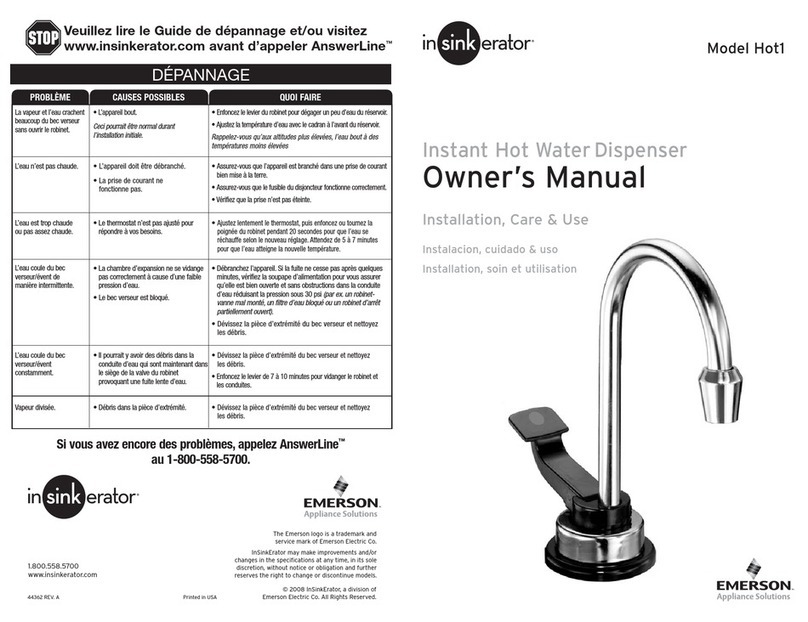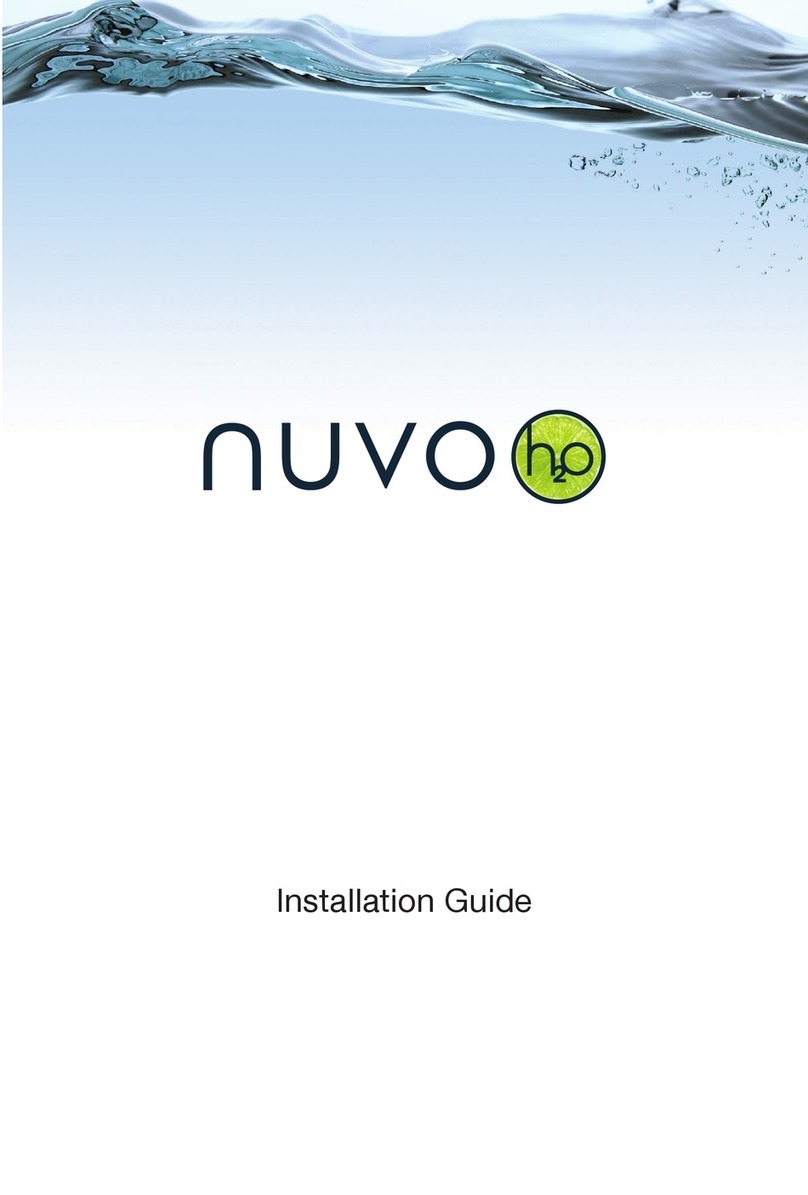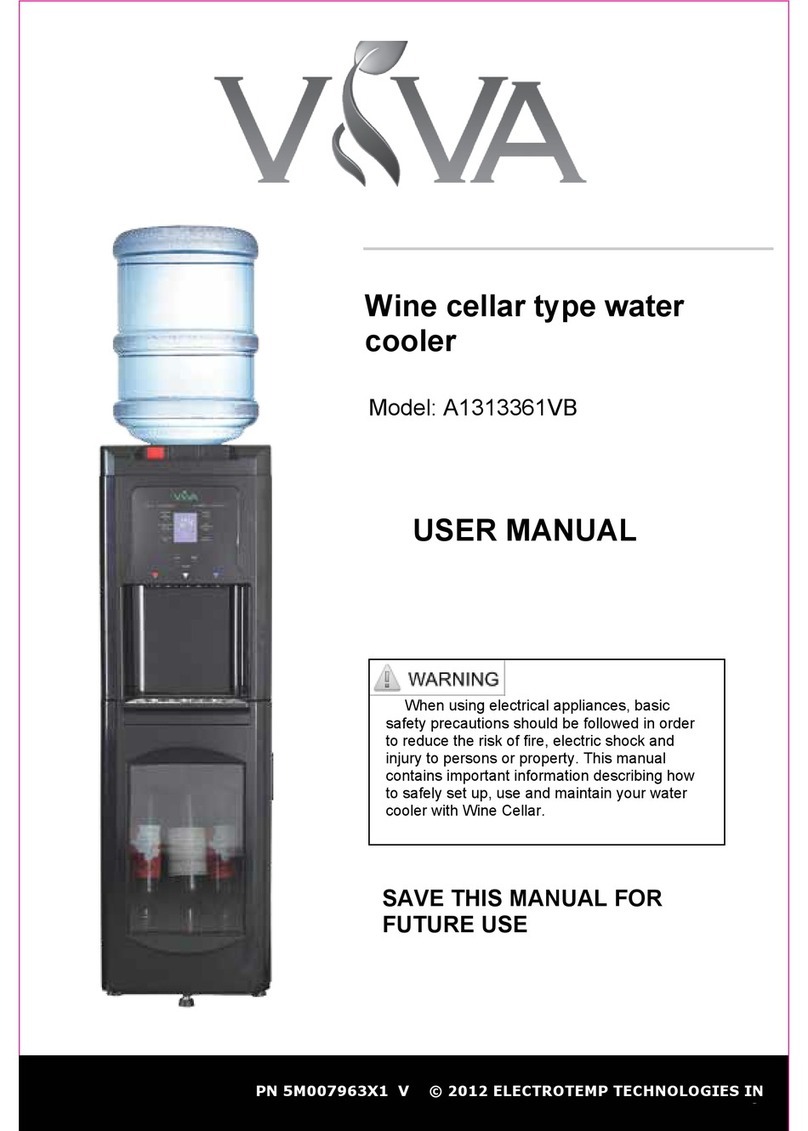Aerus Origins WC400 User manual

Operation Manual
00947-1864 EA-03632

2
Table of Contents
How To Use This Manual............................................................................................................................................4
Safety Information .....................................................................................................................................................4
Valve Layout ..............................................................................................................................................................5
Control Layout ...........................................................................................................................................................5
System Specifications 716.........................................................................................................................................5
Location Selection .....................................................................................................................................................6
Outdoor Locations......................................................................................................................................................6
System Features........................................................................................................................................................7
Equipment Installation ...............................................................................................................................................8
Water Line and Bypass Connections ........................................................................................................................11
Drain Line Connection..............................................................................................................................................12
Regenerant Line Connections ..................................................................................................................................12
Overflow Line Connection ........................................................................................................................................13
Electrical Connection ...............................................................................................................................................13
System Operation ....................................................................................................................................................14
Cycle Water Flows ...................................................................................................................................................14
Camshaft Cycle Positions.........................................................................................................................................15
Valve Disc Location/Function ...................................................................................................................................15
Disinfection of Water Conditioning Systems .............................................................................................................15
Displays, Icons and Cursors .....................................................................................................................................16
Button Functions......................................................................................................................................................16
Programming Overview ...........................................................................................................................................17
Control Operation.....................................................................................................................................................17
Level I Programming................................................................................................................................................17
Level l Programming................................................................................................................................................18
Level II Programming – P Values..............................................................................................................................19
Programming the Lockout Feature...........................................................................................................................19
Level lll Cycle Programming – C Values....................................................................................................................20
Level IV Viewing History - H Values...........................................................................................................................21
Program Reset.........................................................................................................................................................21
Placing WC400 Water Conditioning System Into Operation (Fill Brine Tank Last) .......................................................22
Placing WC400 Water Conditioning System Into Operation (Fill Brine Tank First) .......................................................23
Manual Regeneration Options ..................................................................................................................................24
WC400 Valve - Exploded View and Parts List............................................................................................................25
Conditioner Tank and Regenerant Tank Assembly - Exploded View and Parts List .....................................................26
Brine Well Assembly (CH15675) Exploded View and Parts List..................................................................................27
Troubleshooting .......................................................................................................................................................28
Limited Warranty .....................................................................................................................................................30

3
Aerus - Origins WC400 Water Softener System Performance Data Sheet
Model Origins WC400
Rated Service Flow (gpm) 13.0
Pressure Drop at Rated
Service Flow Rate (psi) 11.0
Rated Capacity
(grains @ lb. of salt)
20,023 @ 4.95 lbs.
39,609 @ 13.5 lbs.
47,665 @ 22.5 lbs.
Rated Efficiency
(grains/lb. Salt @ lb. of salt) 4,045 grains/lb. @ 4.95 lbs.
Maxium Flow Rate During
Regeneration (gpm) 5.5
10% cross linked
Ion Exchange Resin (ft3)1.5
Tank Size 12" x 48"
Backwash - GPM 3.9
Rapid Rinse/purge - GPM 5.5
Operating Pressure: 20 - 125 psi or 1.4 - 8.8 kg/Centimeter2, Operating Temperature: 34 - 110° F or 1.1 - 43.3° C
Acceptable Salt Type: Sodium Chloride - Pellet
All Systems above tested at 35 psi +/- 5 psi, pH of 7.5 +/- 0.5, Capacity Testing Flow Rate = 50% of the rated service
flow rate for the various size systems.
These water softener systems have been tested by WQA and conform to NSF/ANSI 44 for specific performance claims as verified
and substantiated by test data. The rated salt efficiencies above were also determined in accordance with NSF/ANSI 44 and are only
valid at the salt dosage referenced above. An efficiency rated water softener is a demand initiated regeneration (DIR) softener which
also complies with specific performance specifications intended to minimize the amount of regenerant brine and water used in its
operation. Efficiency rated water softeners shall have a rated salt efficiency of not less than 3350 grains of total hardness exchanged
per pound of salt (based on NaCI equivalency) (477 grams of total hardness exchanged per kilogram of salt), and shall not deliver
more salt than its listed rating. The rated efficiency of the water softener, the salt dosage at that efficiency, the capacity at that salt
dosage and that of the efficiency is only valid at the stated salt dosage. Efficiency is measured by a laboratory test described in NSF/
ANSI 44. The test represents the maximum possible efficiency the system can achieve. Operational efficiency is the actual efficiency
achieved after the system has been installed. It is typically less than the efficiency due to individual application factors including water
hardness, water usage, and other contaminants that reduce the water softener's capacity. These systems are not intended to be used
for treating water that is microbiologically unsafe or of unknown quality without adequate disinfection before or after the system.
Refer to the system Installation and Service Manual for set-up and programming instructions. Contact your local Aerus dealer for parts
and service.
Tested and Certified by WQA against NSF/ANSI Std. 44 for softener
performance & Std. 372 for "lead free" compliance and CSA B483.1.
The valve used on this unit is Tested and Certified by WQA against
NSF/ANSI Std. 61 Section 8 for Material Requirements Only.
Aerus LLC
5420 LBJ Freeway, Suite 1010
Dallas, Texas 75240
1-800-243-9078
C USA
®

4
How To Use This Manual
This installation manual is designed to guide the installer through
the process of installing and starting water conditioning systems
featuring WC400 equipment.
This manual is a reference and will not include every system
installation situation. The person installing this equipment should
have:
• Knowledge of water conditioning and how to determine
proper control settings.
• Adequate plumbing skills and qualifications per local and
state laws, codes, and ordinances.
Note: Aerus assumes no liability for damage due to leakage
and/or improper installation
Icons That Appear In This Manual
WARNING: Failure to follow this instruction
can result in personal injury or damage to the
equipment.
Note: Helpful hint to simplify procedure.
Safety Information
• Observe all warnings that appear in this manual.
• Please review the entire Installation and Operation Manual
before installing the water conditioning system.
• As with all plumbing projects, it is recommended that a
trained professional water treatment dealer install the water
conditioning system. Please follow all local plumbing codes
for installing this water conditioning system.
WARNING: Excessive Weight Hazard. Use
two or more people to move and install the
conditioner. Failure to do so can result in injury
(including back injury).
• System is not intended to be used for treating water that
is microbiologically unsafe or of unknown quality without
adequate disinfection before or after the system.
• This water conditioning system is to be used only for
potable water.
• Inspect the water conditioning system for carrier shortage
or shipping damage before beginning installation.
• Use only lead-free solder and flux, as required by federal
and state codes, when installing soldered copper plumbing.
• Use caution when installing soldered metal piping near the
water conditioning system. Heat can adversely affect the
plastic control valve and bypass valve.
• All plastic connections should be hand tightened. Plumber
tape may be used on connections that do not use an O-ring
seal. Do not use pipe dope type sealants on the valve body.
Do not use pliers or pipe wrenches.
• Do not use petroleum-based lubricants such as Vaseline,
oils, or hydrocarbon-based lubricants. Use only 100%
silicone lubricants.
• Use only the power transformer supplied with this water
conditioning system.
• All electrical connections must be completed according to
local codes.
• The power outlet must be grounded.
Install an appropriate grounding strap across the inlet and outlet
piping of the water conditioning system to ensure that a proper
ground is maintained.
WARNING: Dry location use only, unless used
with a Listed Class 2 Power Supply suitable for
outdoor use.
• To disconnect power, unplug the AC adapter from its power
source.
• Observe drain line requirements. The drain line must be
a minimum of 1/2-inch diameter. Use 3/4-inch pipe if the
backwash flow rate is greater than 5 gpm (19 Lpm) or the
pipe length is greater than 20 feet (6 m).
• Do not support the weight of the system on the control
valve fittings, plumbing, or the bypass.
• Do not allow this water conditioning system to freeze.
Damage from freezing will void this water conditioning
system’s warranty.
• Operating ambient temperature: 34° to 120°F
(1° to 49°C).
• Operating water temperature: 35° to 100°F
(1.7° to 38°C).
• Operating water pressure range : 20 to 125 psi
(1.38 to 8.62 bar). In Canada the acceptable operating
water pressure range is 20 to 100 psi
(1.38 to 6.89 bar).
WARNING: The valve and tank components of this
WC400 unit have been assembled and tightened
to the proper factory torque specifications. Over
tightening may result in improper valve, probe and
tank alignment and may damage the tank O-ring (PN
1010154).
• Keep the media tank in the upright position. Do not turn
upside down or drop. Turning the tank upside down or
laying the tank on its side can cause media to enter the
valve.
• Ensure that all wiring and plumbing connections on the
mineral and brine tanks are installed correctly.
• Use only regenerants designed for water conditioning. Do
not use ice melting salt, block salt or rock salt.

5
Control Layout
Time/Day
Regeneration Time/Day
Salt Amount
SU MO TU WE TH FR SA DAYS
PM
Capacity
Check Salt
AC Adapter Connection
(12 Volt Input)
Motor & Optical Sensor
Connection
Analyzer Probe
Connection
System Specifications 716
Model Number 268-716-150-1248
Recharge Style Analyzer
Media Tank Size 12" x 48" (30.5 x 122 cm)
Resin Volume 1.5 ft3(0.04 m3)
Recharge (Salt) Tank Size 19" x 36" (48.3 x 91.5 cm)
Salt Storage 240 lbs (109 kg)
Drain Water Rate 3.9 gpm (14.7 L/m)
Service Connection Size 1" NPT
Drain Connection Size 3/4" NPT
Recharge (Brine) Connection Size 3/8" NPT
Installation Space Requirements 21" x 42" x 72" (53.3 x 106.6 x 182.8 cm)
Shipping Weight 165 lbs (74.8 kg)
Front Back
Valve Layout
Control
Refill Controller
Valve Discs
One Piece Valve Disc Spring
Injector and Cap
Regenerant Tube Connection
Motor
Outlet
Drain
Inlet
Backwash Drain Control
Injector Screen Filter
Optical Sensor
Camshaft

6
Location Selection
Location of a water conditioning system is important. The
following conditions are required:
• Level platform or floor.
Note: The WC400 System can be provided with optional leveling
feet that may be used on the two tanks. Order part number
4000409.
• Room to access equipment for maintenance and adding
regenerant (salt) to tank.
• Ambient temperatures over 34°F (1°C and below 120°F
(49°C).
• Water pressure below 125 psi (8.62 bar) and above 20 psi
(1.38 bar).
• In Canada the water pressure must be below 100 psi (6.89
bar).
• Constant electrical supply to operate the control.
• Total minimum pipe run to water heater of ten feet (three
meters) to prevent backup of hot water into system.
• Local drain for discharge as close as possible.
• Water line connections with shutoff or bypass valves.
• Must meet any local and state codes for site of installation.
• Valve is designed for minor plumbing misalignments. Do not
support weight of system on the plumbing.
• Be sure all soldered pipes are fully cooled before attaching
plastic valve to the plumbing.
WARNING: Dry location use only, unless used
with a Listed Class 2 Power Supply suitable for
outdoor use.
Outdoor Locations
It is recommended that the WC400 conditioner be installed in a
protected environment.
When installing the water conditioning system outdoors, several
items must be considered:
• Moisture – The valve and control are rated for NEMA 3
locations. Falling water should not affect performance. The
system is not designed to withstand extreme humidity or
water spray from below. Examples are: constant heavy
mist, near corrosive environment, or upwards spray from
sprinkler. Ensure that the Analyzer probe access panel is
installed on the unit.
• Direct Sunlight – The materials used will fade or discolor
over time in direct sunlight. The integrity of the materials
will not degrade to cause system failures.
• Temperature – Extreme hot or cold temperatures will cause
damage to the valve or control. Freezing temperatures
will freeze the water in the valve. This will cause physical
damage to the internal parts as well as the plumbing
and conditioning resin. High temperatures will affect the
control. The display may become unreadable but the control
should continue to function. When the temperature returns
to normal operating limits, the display will re-appear.
A protective cover should assist with high temperature
applications.
• Insects – The control and valve have been designed to keep
all but the smallest insects out of the critical areas. Any
holes in the top plate can be covered with duct tape. The
top cover should be installed securely in place.
WARNING: HEAVY LIFT. Lifting unit without
assistance could result in serious injury. Use
two people, lifting aids and proper lifting
techniques when moving unit.

7
System Features
Resin Tank
1 Cover 9 Foot, Leveling
2 Cap, Cover 10 Latch Mechanism
3Jacket, Resin Tank 11 Tank Collar
4 Base 12 Riser Tube
5 268 Logix PE Valve
w/716 Control
13 Upper Basket
6Resin Tank 14 Cover
7Door, Access, Sensor 15 Shield
8Sensors Wired Probes
Brine Tank
1 Cover 5 Brine Tube Assembly
2Collar, Tank 6 Foot, Leveling
3 Tank, Brine 7 Latch Mechanism
4Base, Tank
1
2
3
4
5
6
7
9
10
11
12
13
14
15
8
1
2
3
4
5
6
7

8
Equipment Installation
Dimensions
36.9 (938.1)
60.7 (1541.6)
19.8
(503.8)
16.8 (427.1)
17.6 (447)
20.5 (521.1)
35.1 (890.4)
28.2 (715.9)
32.2 (817.5)
53.4 (1356.6)
55 (1398.1)
5.0 (127)
2.5 (63.5)

9
Typical System Layout
Laundry Tubs
Pump
or
Meter
Hot Water
Outlet
Outside
Faucet
Outside
Faucet
Water
Heater
Bath Tub Lavatory Toilet Kitchen
Floor Drain
Figure 1 Standard Basement Before Installation. Cold water lines shown.
Soft Water
Hard Water
Outside
Faucet
Outside
Faucet
Bath Tub Lavatory Toilet Kitchen
Laundry Tubs
Pump
or
Meter
Hot Water
Outlet
Water
Heater
Brine Tank Overflow Drain
Floor Drain
Drain Line
Bypass
Softener
Grounding
Strap
Figure 2 Softened Water Flow Diagram.

10
Inspection
The WC400 system is shipped with several parts unassembled.
When parts are removed from the packing, they should be
inspected for damage. If any parts are damaged or missing,
contact your supplier.
WARNING: When handling the media tank do
not turn it upside down or drop on its side.
When the carton is first opened, the softener will be standing
upright. The salt tank will be turned over and covering the softener
(Figure 3).
Salt Tank Base
Salt Tank Cover
Salt Tank Collar
Brine Tube
Assembly
Salt Tank
(Upside Down)
Media Tank
(Softener)
Media Tank Base
Figure 3
To assemble the system, remove the salt tank components (cover,
collar, base and brine tube assembly) from the shipping container.
The media tank can now be removed. Locate the miscellaneous
parts bag.
To assemble the Salt Tank:
1. If the floor under the salt tank is uneven, the leveling feet may
be installed. Lay the empty salt tank on its side. Press or tap
the feet into the pockets.
2. Stand the salt tank up and in position. Level as needed. The
tank has two ports that will be connected. One to a drain and
one to the valve.
3. Place the brine tube in position inside the pocket at the
bottom of the tank. Install the overflow fitting.
4. Place the tank collar over the top of the brine tube. Position
the collar and push it down into the tank. Lay the cover aside
for now.
To Assemble the Media Tank:
1. If the floor under the media tank is uneven, the leveling feet
may be installed. Slowly lay the tank on its side. Press or tap
the feet into the pockets.
WARNING: The media tank contains loose
particles that will shift. If the tank is turned
upside down or laid back quickly, the particles
may enter the valve. If this happens, the valve
may need to be disassembled and cleaned.
2. Stand the tank up and in position. Level as needed.
3. Remove cover by pressing in on the latch and lifting cover
(Figure 4). When the cover is removed, the valve is visible.
Remove the remote salt detector and the power adapter.
They should be secured to the tank collar near the inlet/outlet
connections.
Lift
Press in
Figure 4
Tank and Probe Assembly
The probes are preinstalled to the media tank. The probes are
located behind an access panel on the jacket of the media tank. To
remove the access panel, remove the four screws and washers.
Use only 100% silicone lubricant on the probe O-rings (Figure 5).
Do not allow the lubricant to come into contact with the probe
pins. Install the probe assemblies into the tank and secure with
the locking clasp (Figure 6).
Important: The pins on the probes will only fit into the bulkhead
fittings one way. The pins must go into the matching holes at the
bottom of the fitting. The probe with the shortest length of wire
must be on top.
Install the protective shield (Figure 6 ).
Note: Do not attempt to tighten or loosen the Bulkhead fittings,
as they are secured with a locking adhesive.

11
O-ring
Probe Pins
Lubricate
Probe
Figure 5
Bulkhead
Fitting
Locking Clasp
Figure 6
Water Line and Bypass Connections
A bypass valve system should be installed on all water
conditioning systems. A model 1265 bypass is included with
this system. The bypass valve isolates the conditioner from the
water system and provides unconditioned water to service during
routine maintenance and servicing procedures. See Figure 7
Model 1265 Bypass (Included) and Figure 8 Typical Three Valve
Bypass Configuration (Not provided by manufacturer).
Note: Before turning on the water to the valve, rotate the two
handles on the bypass valve 2-3 times. This will help seat the
O-rings and prevent leaking.
Normal Operation In Bypass
B
Y
P
A
S
S
B
Y
P
A
S
S
B
Y
P
A
S
S
B
Y
P
A
S
S
Water Conditioner Water Conditioner
In Out In Out
Figure 7 Model 1265 Bypass (Included)
Water
Conditioner
Water
Conditioner
Water Conditioner Water Conditioner
Normal Operation In Bypass
Figure 8 Typical Three Valve Bypass Configuration
(Not provided by manufacturer)
WARNING: Do not use tools to tighten plastic
fittings. Over time, stress may break the
connections. Hand tighten the nuts.
WARNING: Do not use petroleum grease on
gaskets when connecting bypass plumbing.
Use only 100% silicone grease products when
installing any WC400 brand valve. Non-silicone
grease may cause plastic components to fail
over time.
WARNING: The inlet water must be connected
to the inlet port of the valve. When replacing
non-WC400 valves, it is possible that the inlet
and outlet plumbing is installed in a reversed
position. Ensure that the plumbing is not
installed in the opposite order. Tank media may
be pushed into the valve.

12
Drain Line Connection
Note: Standard commercial practices are expressed here. Local
codes may require changes to the following suggestions. Check
with local authorities before installing a water conditioning
system.
1. The unit should be above and not more than 20 feet (6.1 m)
from the drain. Use an appropriate adapter fitting to connect
1/2-inch (1.3 cm) plastic tubing to the drain line connection of
the control valve.
2. If the backwash flow rate exceeds 5 gpm (22.7 Lpm) or if
the unit is located 20-40 feet (6.1 – 12.2 m) from drain, use
3/4-inch (1.9 cm) tubing. Use appropriate fittings to connect
the 3/4-inch tubing to the 3/4-inch NPT drain connection on
valve.
3. The drain line may be elevated up to 6 feet (1.8 m) provided
the run does not exceed 15 feet (4.6 m) and water pressure
at the conditioner is not less than 40 psi (2.76 bar). Elevation
can increase by 2 feet (61 cm) for each additional 10-psi (.69
bar) of water pressure at the drain connector.
4. When the drain line is elevated but empties into a drain below
the level of the control valve, form a 7-inch (18 cm) loop at
the far end of the line so that the bottom of the loop is level
with the drain line connection. This will provide an adequate
siphon trap. Tie or wire the hose in place at the drain point.
Also provide an air gap of at least 1-1/2 inch between the end
of the hose and the drain point.
5. When the drain empties into an overhead sewer line, a sink-
type trap must be used.
6. Secure the end of the drain line to prevent it from moving.
Figure 9 Drain Line Connection
WARNING: Never insert drain line directly into
a drain, sewer line or trap (Figure 9). Always
allow an air gap between the drain line and the
wastewater to prevent the possibility of sewage
being back-siphoned into the conditioner.
Regenerant Line Connections
The regenerant line from the brine tank safety brine valve (Figure
11) connects to the valve. Make sure both safety valve tube
fittings are tight. Make the connections and hand tighten.
Note: Be sure that the regenerant line is secure and free from
air leaks. Even a small leak may cause the regenerant line to
drain out, and the conditioner will not draw regenerant from
the tank. This may also introduce air into the valve causing
problems with valve operation.
Ensure that plumber tape pipe sealant is applied to the 3/8-inch
NPT regenerant line connection (Figure 10).
Regenerant Line Connection
Figure 10
Regenerant Line Connection
Figure 11 Salt Tank Safety Brine Valve
and Brine Well Assembly
Tube Fitting

13
Overflow Line Connection
In the event of a malfunction, the regenerant tank overflow will
direct “overflow” to the drain instead of spilling on the floor. This
fitting should be on the side of the cabinet or regenerant tank,
Figure 12.
To connect the overflow line, locate the connection on side of the
regenerant tank. Insert overflow fitting into tank and tighten with
plastic thumb nut and gasket. Attach length of 1/2-inch (1.3 cm)
I.D. tubing (not supplied) to fitting and run to drain. Do not elevate
overflow line higher than overflow fitting.
Do not tie into drain line of control unit. Overflow line must be a
direct, separate line from overflow fitting to drain, sewer or tub
with an air gap at the drain.
Regenerant Line Opening
Overflow Fitting
Drain Tubing
Secure hose
in place
Drain
Air Gap
Figure 12
Electrical Connection
Note: There are no user serviceable parts in the AC adapter,
motor or the control board.
The Analyzer control operates on a 12-volt alternating current
power supply. This requires use of the supplied AC adapter. AC
adapters are available from your supplier for different applications.
They include:
AC Adapter Input Voltage Application Part Number
Standard
wall-mount 120V 60 Hz UL listed for
dry locations 1000811
Outdoor rated 120V 60 Hz
UL listed
for outdoor
installations
1235448
120V AC Adapters:
Make sure power source matches the rating printed on the AC
adapter.
Note: The power source should be constant. Be certain the AC
adapter is not on a switched outlet. Power interruptions longer
than eight hours may cause the control to lose the day and time
settings. When power is restored, the control will display four
dashes (- - :- -) indicating that the day and time settings must
be re-entered.

14
System Operation
Treated Water (Downflow)
Untreated water is conditioned as it flows through the resin bed
and up the riser.
If the model selected at first start-up was 268r, this is a system
that will refill the salt tank at the start of a regeneration cycle.
When a regeneration cycle begins, the salt tank is filled and brine
is allowed to develop before Cycle 1 starts.
Backwash (Upflow) – Cycle C1
Flow is reversed by the control valve, directed down the riser, up
through the resin bed and sent to drain. The bed is expanded and
debris is flushed to the drain.
Regenerant Draw (Downflow) – Cycle C2*
Water passes through the injector and regenerant is drawn from
the regenerant tank. The regenerant is directed to the resin bed.
The hardness ions are displaced by sodium ions. Regenerant
draw is completed when the air check closes.
Slow Rinse (Downflow) – Cycle C3*
Water flow moves the regenerant through the resin at a specific
rate and rinses to the drain. The resin is regenerated.
Repressurization – Cycle C4
Pressure is balanced in the valve before continuing the
regeneration.
Fast Rinse (Downflow) – Cycle C5
Water passes through the resin bed and up through the riser
to drain. All remaining regenerant residual is rinsed from the
resin bed.
2nd Backwash (Upflow) – Cycle C6
Flow is identical to C1 Backwash. The resin is reclassified.
2nd Rinse (Downflow) – Cycle C7
Flow is identical to C5 Fast Rinse. The resin bed is rinsed
to quality.
Regenerant Refill Last – Cycle C8
Refill last only occurs if the model selected at first power up
was 268.
Water is directed to the regenerant tank to create regenerant
for the next regeneration.
Cycle Water Flows
Backwash Fast Rinse
Service Regenerant Draw/
Slow Rinse
From
Regenerant Tank
Repressurize
To Regenerant
Tank
Refill
*The camshaft does not change position between C2 and C3 cycles. C2 is only momentarily displayed.

15
Camshaft Cycle Positions
The front end of the camshaft has an indicator cup. The cup has
slots in the outer edge and cycle numbers on the inside face
(Figure 18).
Remove the cover and look over the top of the Analyzer control
to view the cycle numbers. The number at the top indicates the
current cycle position of the control valve. The corresponding slot
for the number is positioned at the optical sensor, which is rotated
approximately 90 degrees out of phase.
Note: If electrical power is not available, the camshaft can be
rotated counterclockwise by hand if the motor
is removed.
Treated Water
Cycle Number
Treated
Water Slot
Figure 13
Cycle Indicators:
0 = Treated Water or brine make-up if recharge cycle
has started.
1 = Backwash Cycle
2 = Regenerant Draw Cycle
3 = Slow Rinse Cycle
4 = System Pause
5 = Fast Rinse Cycle 1
6 = 2nd Backwash
7 = 2nd Fast Rinse
8 = Regenerant Refill (if system is 268r, regenerant
refill takes place before backwash cycle #1)
Valve Disc Location/Function
Figure 14 Valve
Disinfection of Water Conditioning Systems
The materials of construction in the modern water conditioning
system will not support bacterial growth, nor will these materials
contaminate a water supply. During normal use, a conditioner may
become fouled with organic matter, or in some cases with bacteria
from the water supply. This may result in an off-taste or odor in
the water.
Some conditioners may need to be disinfected after installation
and some conditioners will require periodic disinfection during
their normal life.
Depending upon the conditions of use, the style of conditioner, the
type of ion exchanger, and the disinfectant available, a choice can
be made among the following methods.
Sodium or Calcium Hypochlorite
These materials are satisfactory for use with polystyrene resins,
synthetic gel zeolite, and bentonites.
5.25% Sodium Hypochlorite
These solutions are available under trade names such as Clorox*.
If stronger solutions are used, such as those sold for commercial
laundries, adjust the dosage accordingly.
1. Dosage
• Polystyrene resin; 1.2 fluid ounce (35.5 mL)
per cubic foot.
• Non-resinous exchangers; 0.8 fluid ounce
(23.7 mL) per cubic foot.
2. Regenerant tank conditioners
A. Backwash the conditioner and add the required
amount of hypochlorite solution to the well of the
regenerant tank. The regenerant tank should have
water in it to permit the solution to be carried into the
conditioner.
B. Proceed with the normal regeneration.
Calcium Hypochlorite
Calcium hypochlorite, 70% available chlorine, is available in
several forms including tablets and granules. These solid materials
may be used directly without dissolving before use.
1. Dosage
A. Two grains (approximately 0.1 ounce (3 mL)
per cubic foot.
2. Regenerant tank conditioners
A. Backwash the conditioner and add the required
amount of hypochlorite to the well of the regenerant
tank. The regenerant tank should have water in it
to permit the chlorine solution to be carried into the
conditioner.
B. Proceed with the normal regeneration.
2 Bypass Valve
4 Outlet Valve 6 Rinse Drain
1 Regenerant Valve
3 Inlet Valve 5 Refill
Valve
7 Backwash
Drain Valve
*Clorox is a trademark of the Clorox Company.

16
Displays, Icons and Cursors
Figure 15
Note: In normal operation and during programming, only a few
of the icons will actually be displayed.
1. Used to select and indicate the actual Day of the Week setting.
2. This cursor is displayed when programming the Days
Override.
3. PM indicator displayed when setting Time of Day and Time
of Regeneration. Note: There is no AM indicator.
4. Indicates displayed value in minute increments.
5. Indicated kilograins or kilograms when estimated capacity
is displayed.
6. Used to display “P”, “H”, and “C” parameter.
7. Indicates access into “H” Level IV History viewing.
8. Indicates access into “P” Level ll programming.
9. Used to display cycle position during regeneration. Also
indicates access into “C” Level III cycle programming.
10. This cursor is displayed during Level l programming: Time
of Day, Regen Time, Day, Salt, etc.
11. When flashing, this indicates regeneration is to occur at next
Time of Regen. Appears as a solid icon during regeneration.
12. When hourglass is flashing, this indicates that the control is
moving to a regeneration cycle. Appears as a solid icon during
a cancelled regeneration and the control is cycling directly
back to the home position.
13. Indicates the selected program setting has been locked out.
Lock settings are changed in Level II programming.
14. Indicates double regeneration.
15. Normally off. Will glow red if salt brine is not reaching the
valve during recharge. Indicates out-of-salt condition.
16. Maintenance display turns on if the months in service exceed
the value programmed in P11 “Service Interval”.
17. When Lbs/ft3is displayed, the value for regenerant amount
entered is in pounds per cubic foot.
18. X100 multiplier for large values.
19. When “g/L” is displayed the valve is in grams per liter.
Button Functions
Figure 16
DOWN and UP Arrows: Used to scroll through settings
or change setting value.
SET: Used to enter a setting into memory or activate a setting
to be changed.
REGEN: Used to command the control to regenerate
and enable or disable lockout setting.
Time/Day
Regeneration Time/Day
Salt Amount
Capacity
g/L
PM
MIN
KGx2
x100P
H
C
Lbs/ft3
Check Salt
13
14
1
2
3
4
19
5
18
171667
15
9
10
8
11
12
SU MO TU WE TH FR SA DAYS
Down Arrow
Set
Up Arrow
For Regeneration

17
Programming Overview
The Analyzer control includes multiple program levels that allow
the Water Treatment Professional to customize the system
for many water conditions. Additionally, historical data can be
viewed allowing quick and easy troubleshooting. In most cases,
Level I programming is all that is required to set up the water
conditioning system for proper operation. A brief description of
each program level is listed below.
• Level l: Used to program control for normal applications.
• Level ll: (P-Values) Allows the installer to customize
programming for non-standard applications.
• Level lll: (C-Values) Allows the installer to adjust the length
of select cycles for non-standard applications.
• Level IV: History (H-Values) Allows access to historical
information for troubleshooting the system.
Note: If a button is not pushed for thirty seconds, the control
returns to normal operation mode.
Control Operation
Power Loss Memory Retention
The Analyzer control features battery-free Time of Day and Day of
Week retention during loss of power. A super capacitor is designed
to hold the information in memory for 8 to 24 hours depending on
the installation. If the super capacitor is exhausted, the Analyzer
control will display four dashes (- - :- -) immediately upon power
up. The Time of Day and Day of Week must be reset.
All other programmed parameters are stored in the static memory
and are retained during power outages.
Level I Programming
The Analyzer control can be quickly programmed by following
the sequential procedure on the following page. Level I program
parameters are those that can be accessed by pressing the UP or
DOWN buttons.
• Valve Type: Select 268 for traditional refilling the salt tank
last. Select 268r to have a normally dry salt tank that is
filled when the regeneration cycle starts.
• Resin Volume Setting: Set to match the volume (cubic feet)
of resin in the mineral tank.
• Time of Day: Includes PM indicator. Can be set to display as
a 24-hour clock. See Level ll Programming.
• Day of Week: Set to actual day of the week.
• Time of Regeneration: Fully adjustable. Default is 2:00 AM.
• Days Override: Range 0.5 to 99 days. Leave at 0 to disable.
• Salt Dosage: Set at pounds of salt per cubic foot of resin in
the conditioner tank.
Note: When the control is set up for a twelve-hour clock a PM
indicator will illuminate when the displayed time is in the PM
hours. There is no AM indicator.

18
Level l Programming
Salt Amount
SU MO TU WE TH FR SA DAYS
Capacity
Salt Amount
SU MO TU WE TH FR SA DAYS
Capacity
Salt Amount
SU MO TU WE TH FR SA DAYS
Capacity
Salt Amount
SU MO TU WE TH FR SA DAYS
Capacity
Salt Amount
SU MO TU WE TH FR SA DAYS
Capacity
Salt Amount
SU MO TU WE TH FR SA DAYS
Capacity
Salt Amount
SU MO TU WE TH FR SA DAYS
Capacity
2. Resin Volume
Select correct resin volume
3. Time of Day (12 hr.)
Set to time of day
Note: Setting includes PM indicator.
4. Day of Week
Set to actual day of the week
5. Time of Regeneration
Set to desired time of regeneration
6. Days Override
Leave at 0 to disable
or
Set to desired days between
regeneration
7. Salt Dosage
Set to desired desired dosage
lbs per cubic feet of resin
Screen Buttons to Description Range
Press
or
press
then
or
press
press
then
or
press
press
then
or
press
press
then
or
press
press
then
or
press
press
then
PM
Lbs/ft 3
Time/Day
Regeneration Time/Day
Time/Day
Regeneration Time/Day
Time/Day
Regeneration Time/Day
Time/Day
Regeneration Time/Day
Time/Day
Regeneration Time/Day
Time/Day
Regeneration Time/Day
Time/Day
Regeneration Time/Day
Salt Amount
SU MO TU WE TH FR SA DAYS
Capacity KG
press
Time/Day
Regeneration Time/Day Programming is complete
Estimated exchange capacity (view only)
based on resin volume and salt setting
1. Valve
Type
Salt Amount
SU MO TU WE TH FR SA DAYS
Capacity
PM
Time/Day
Regeneration Time/Day Service Display
or
press
press
then
Displays actual day of the week and time of day.
The In Service LED located on the front of the tank
jacket will be on (steady green).
Model: 268r (Refill First)
268 (Refill Last)
Cubic feet: 1.0 to 2.0
Days: 1 to 30
Lbs/ft3: 3 to 18
Select Model
Note: Upon completing the Level l Programming, the Regen icon will begin flashing, indicating that a delayed regeneration will
occur at the next programmed time of regeneration. If a delayed regeneration is not desired, press the REGEN button to disable
the delayed regeneration and the system will regenerate by water usage.

19
Level II Programming – P Values
Level II program parameters can be adjusted and used to fine-tune the conditioner’s operation. The parameters are accessible by
pressing and holding the UP and DOWN buttons until the control displays a “P” value. Note: The control must be in the home position to
change settings. See Table below for Level ll parameters. Typically the Level ll parameters will not need to be adjusted, as the default
settings accommodate most applications. Contact your Water Treatment Professional before attempting any programming.
P# Description Range Minimum
Increments Default Units Notes
P1 Time of Day 12 Hr
24 Hr 1 Min 12:00PM Hr./Min. Range dependent on P10 setting
P2 Day of Week Sun-Sat 1 Day Sun Days Set to actual day of the week
P3 Time of Regen 12 Hr
24 Hr 1 Min 12:00PM Hr./Min. Range dependent on P10 setting
P4 Day Override 0-30 1 Day 0 Days 0 = Disabled
P5 Not Used
P6 Salt Setting 3-18
50-290
1
10
9
110
Lbs/Cu ft3
g/L Set in Level I Programming
P7 Capacity
(View Only)
1-140
0.1-14.0
1
0.1 Calculated Kilograins
Kilograms Values dependent on P9 setting
P8 Not Used
P9 Units of Measure 0-1 1 0 0 = US 1 = Metric
P10 Clock Mode 0-1 1 0 0 = 12 Hr 1 = 24 Hr
P11 Service Interval 0-99 1 0 Months 0 = Disabled 30 Day Month
P12
Minimum
Days Between
Regeneration
0-14 1 0 Days
P13 Low Salt Sensitivity 0-2 1 2
0 = Highest Sensitivity
1 = Mid Sensitivity
2 = Lowest Sensitivity
3 = Turn Off Check Salt Light Function
P14 Disable Probes 0-1 1 0 0 = Normal Operation
1 = Probes Disabled; No Err6
Programming the Lockout Feature
All parameters can be locked out when the control is in Level ll programming.
Simply press the REGEN button during Level ll programming and a Lock icon
will appear indicating that the specific setting has been locked out. When locked
out, the setting cannot be adjusted. To disable the Lock Out Feature, press the
REGEN button when in Level ll. The lock icon will not be displayed.
Time/Day
Regeneration Time/Day
Salt Amount
SU MO TU WE TH FR SA DAYS
PM
Capacity
Check Salt

20
Level lll Cycle Programming – C Values
Several Level III program parameters can be adjusted to fine-tune a conditioner's operation for non-standard applications.
Typically these parameters will not need to be adjusted, as the default settings accommodate most applications. Contact
your Water Treatment Professional before attempting any programming. The parameters are accessible by pressing and
holding the UP and SET buttons until the display shows a “C” value.
Note: The control must be in the treated water position to change settings.
C# Description Range Minimum
Increments
Default
Setting Notes
C1 Backwash 0 – 200 1 Min 10 Flow rate dictated by size of drain line flow controller
C2 Regenerant
Draw Not Adjustable 1 Min See Notes Automatically calculated from resin volume and
salt dosage settings
C3 Slow Rinse 0 – 200 1 Min See Notes Automatically calculated from resin volume and
salt dosage settings
C4 Repressurization 0 – 200 1 Min 3 Allows system to equalize water pressure across valve discs
C5 Fast Rinse 0 – 200 1 Min 4 Rinses residual regenerant from tank
C6 2nd Backwash 0 – 200 1 Min 1 Disperses non-regenerated areas of the resin bed
C7 2nd Fast Rinse 0 – 200 1 Min 1 Rinses to Quality
C8 Regenerant Refill Not Adjustable 1 Min See Notes Automatically calculated from resin volume and
salt dosage settings
C0 Service/Brine
Prep 0 - 200 1 Min 120 Used in fill first models only. Brine prep allows brine to come
up to concentration after refill.
Table of contents
Languages:
Popular Water Dispenser manuals by other brands
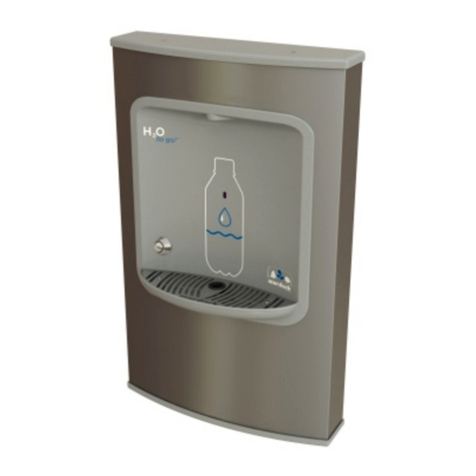
Murdock
Murdock H2O To Go BF15 Series Installation & maintenance instructions
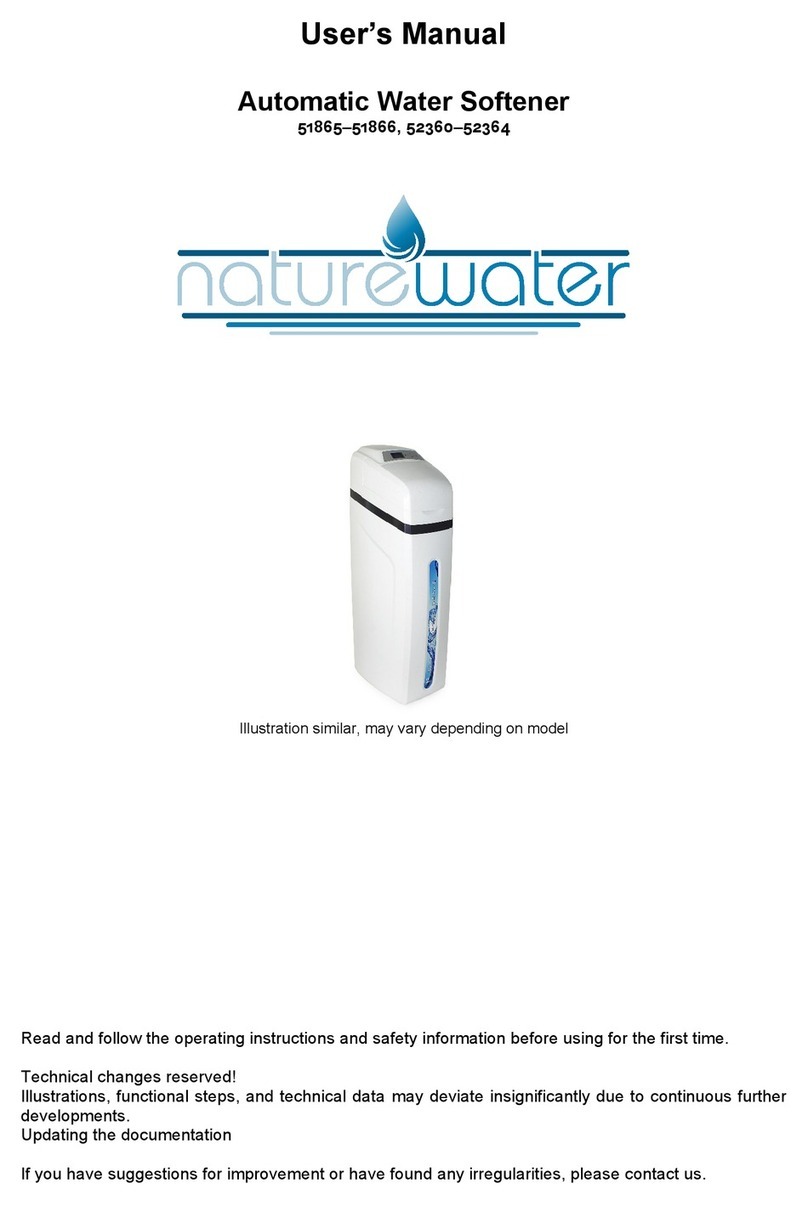
NatureWater
NatureWater 51865 user manual

Kinetico
Kinetico Essential Series Technical manual
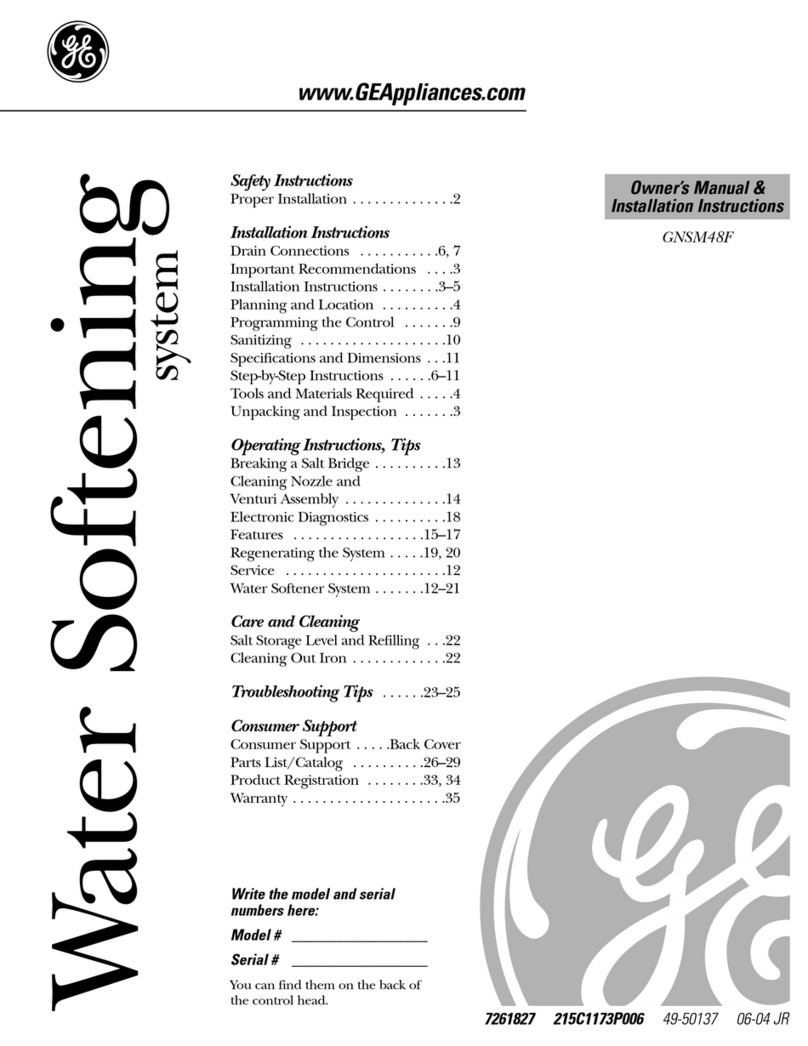
GE
GE GNSM48F Owner's Manual & Installation Instructions

Elkay
Elkay OFAVR14*1 Installation, care & use manual

Culligan
Culligan Super S Installation and operating insctructions

Frigidaire
Frigidaire FQT153MBIW instruction manual
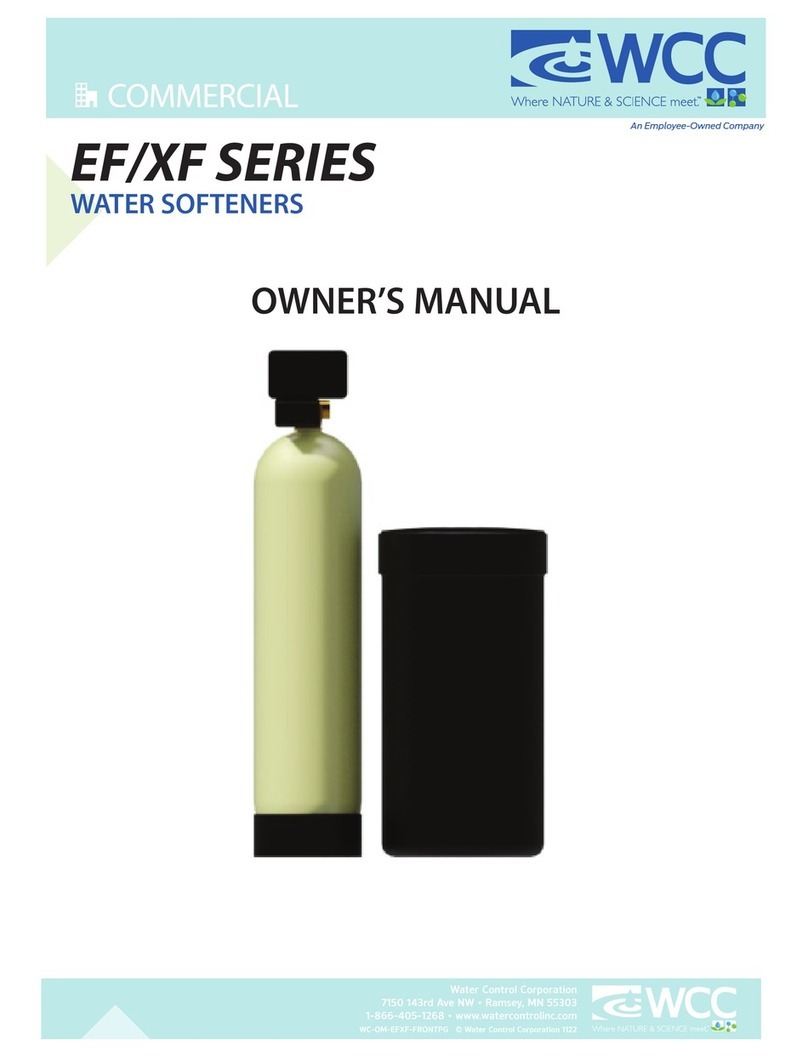
WCC
WCC EF Series owner's manual
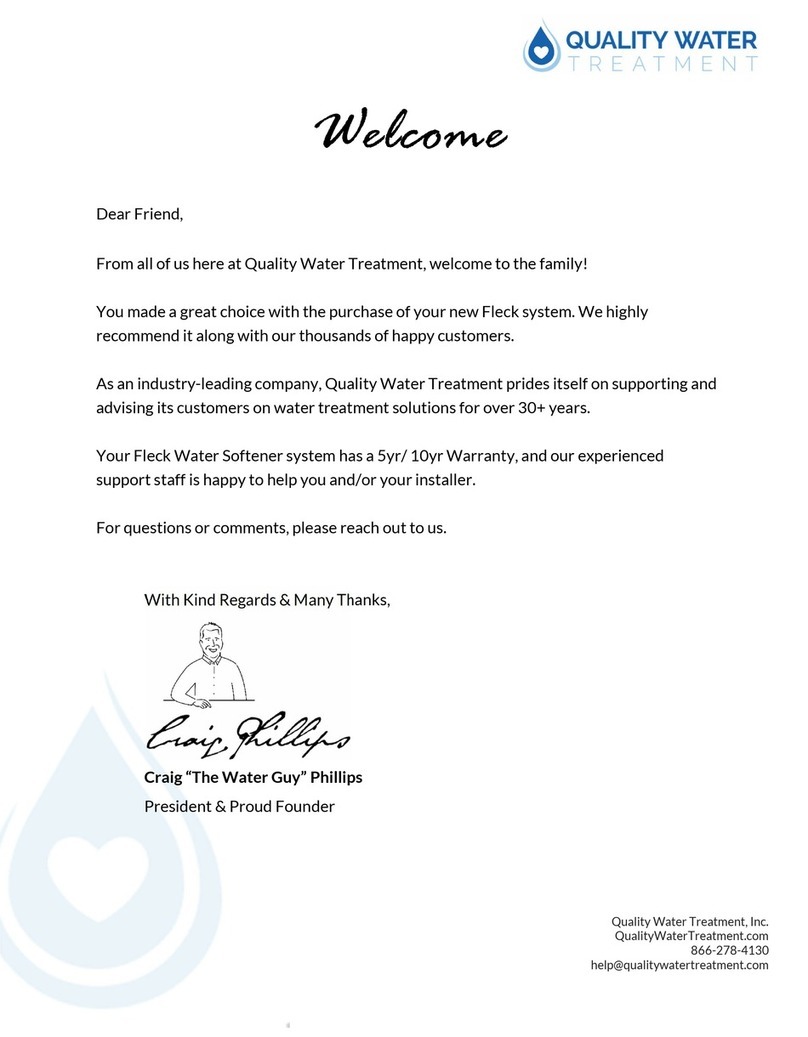
Pentair Pool Products
Pentair Pool Products FLECK 2510SXT installation guide

KitchenAid
KitchenAid KHWG160PCR1 parts list
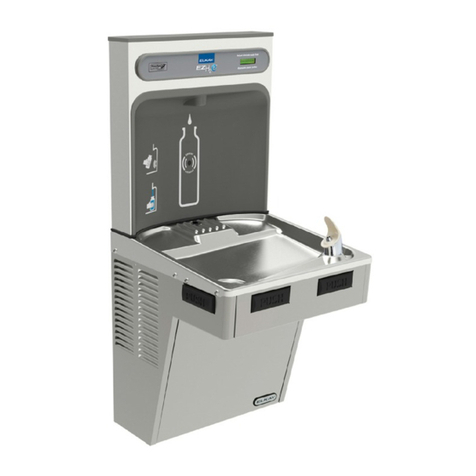
Elkay
Elkay EMABF8WS*1D Series Installation & use manual

Pfannenberg
Pfannenberg Rack Series Operating and maintenance instructions
